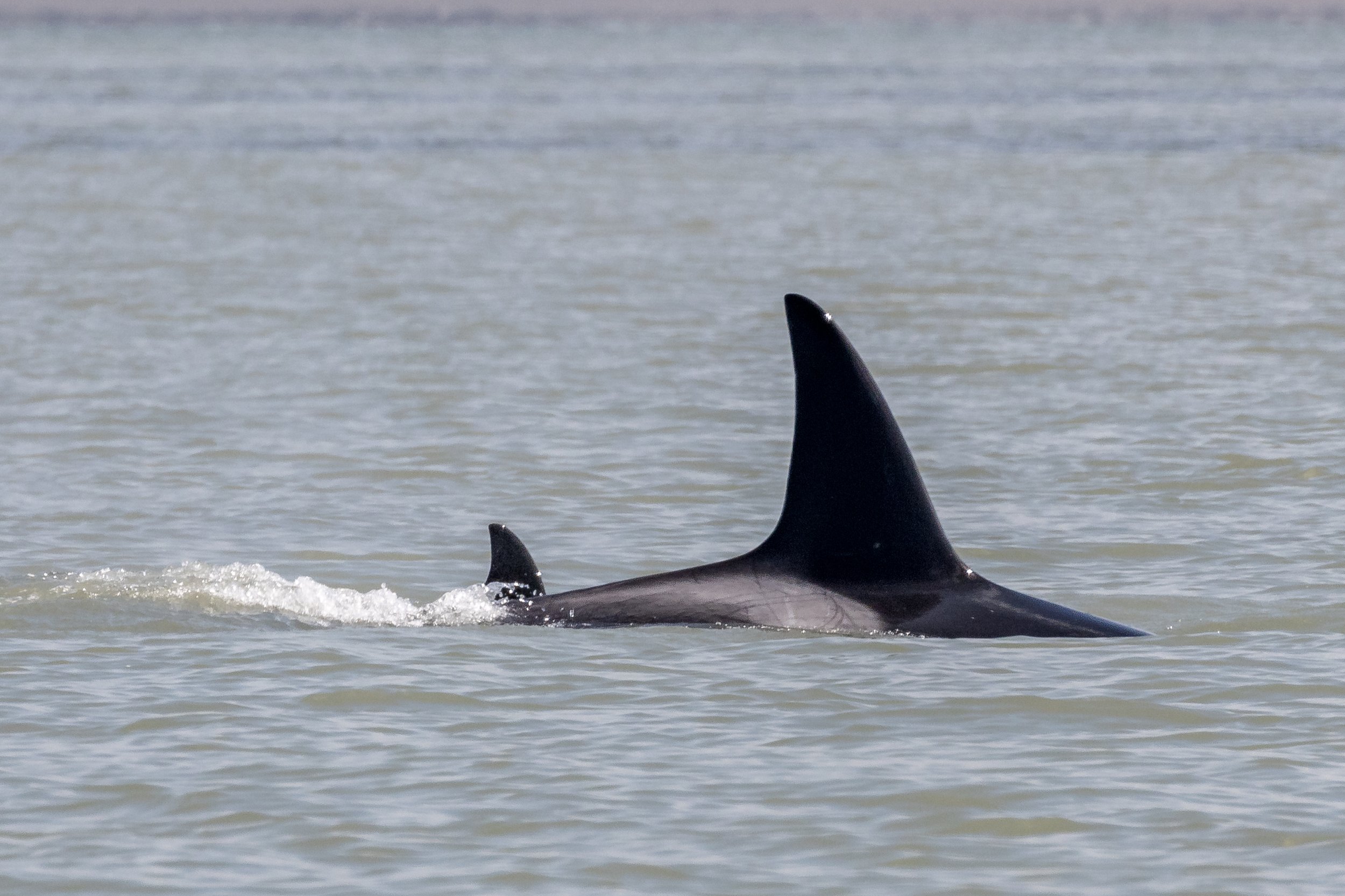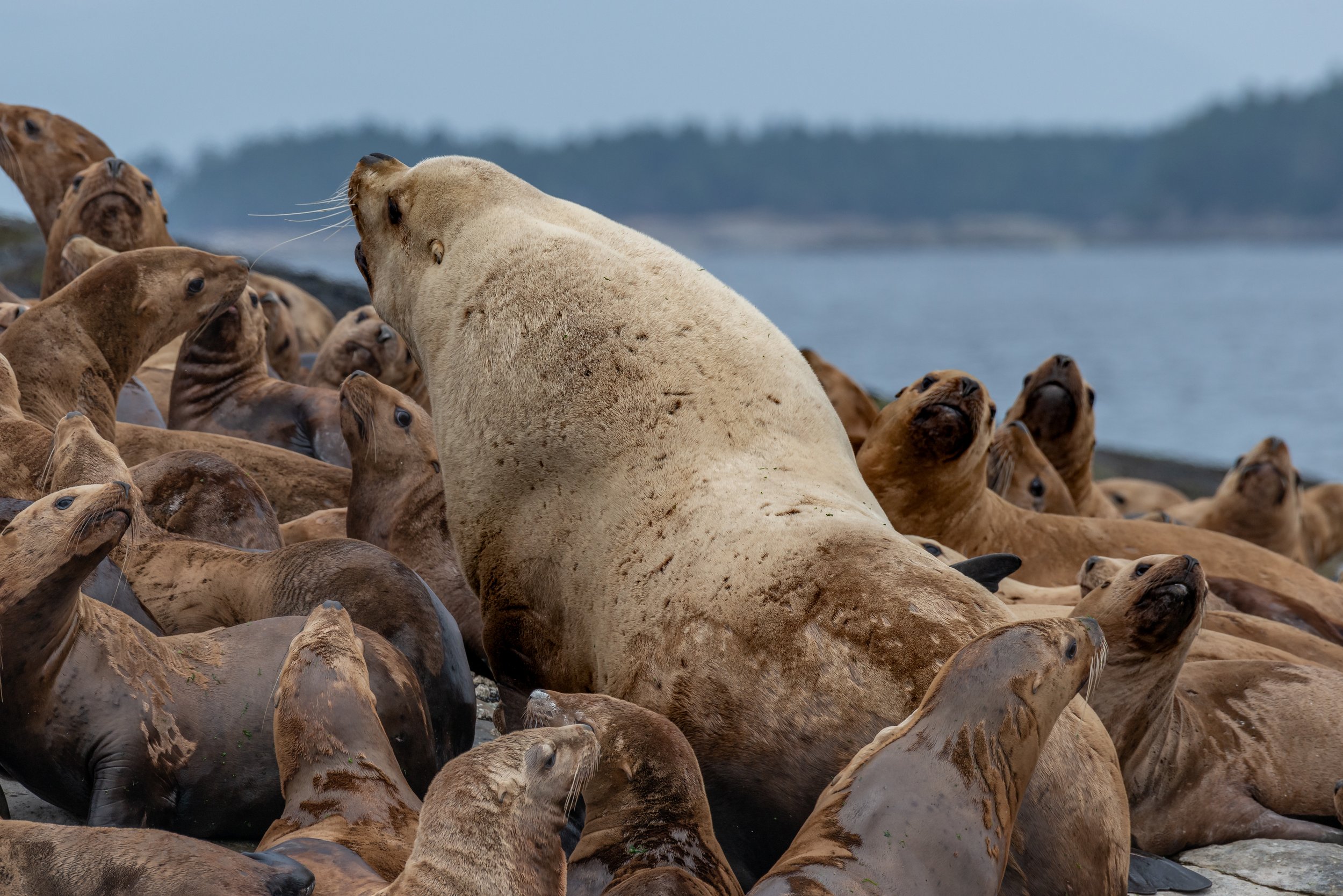June 15, 2023, 10:30 AM - The T-party continues!
Today we got to see the same T-party as yesterday! A T-party occurs when orca from different pods join together to hunt, play and mate with one another. The orcas seen on tour this morning were:
T046B1 Tread ♀ (2003)
T046B1A Tsakani ♀ (2015)
T046B1C (2022)
T046C2 Sam ♀ (2009)
T087 Harbeson ♂ (~1962)
The t-party today was very energetic, performing multiple spy hops and simultaneous surfaces. Often when pods finish a successful hunt, they are filled with energy and celebrate accordingly. Today’s celebration happened to be some curious faces peeking out of the water! Based on research, transient orcas have been shown to have a preference for hunting harbour seals. Sea lions, porpoises and baleen whale calves are also known to be hunted by transient orcas.
Each orca needs to eat about 300 lbs of food each day, therefore, a t-party of five such as this one would need to successfully hunt up to 8 harbour seals each day to be well-fed. There are about 100,000 harbour seals in British Columbia, so there are plenty of them for the orcas to eat and no worries about their populations dwindling any time soon!
Many people often wonder why orcas have the colour pattern that they do on their bodies, with a white underside, white eyepatches and a darker back. This colour contrast between their white belly and their dark back is known as counter illumination! When prey looks up at the orca’s white belly from below them, their belly blends in with the light that comes into the water column from the sunlight above. Looking down at the orca from above, prey would see the dark abyss of the ocean and the back of the orca would blend in nicely with the dark ocean. Counter illumination, therefore, allows an orca to blend in with their surroundings better and act as a sort of camouflage. It is thought to be that orcas have white eyepatches above their eyes because they act as targets for other animals to attack, rather than claw at their actual eyes. Orcas don’t have any natural predators, but their marine mammal prey is known to try to fight back against becoming orca lunch.
Spotted during this morning’s tour were the Steller sea lions at Stinky Rock, and they were quite energetic. During this time of year, they are exhibiting their mating behaviour since the Stellers are approaching the time when they head up to Alaska for their breeding season. Breeding behaviour is very characteristic, with large males that weigh up to 2200 lbs holding down their mating rock, fighting off other males to claim the rock that has 10-16 females laying on it that are hoping to mate with the dominant male. On Stinky Rock, there is certainly no question as to who the dominant male is.
Featured on the other side of Stinky Rock were some Harbour Seals, galumphing along on the rocks. Sometimes our guests use the erm seal and sea lion interchangeably, but there are a few big differences between the two. Sea lions have external ear flaps and are able to hinge their back tail flippers to use them to walk on, whereas seals have no external ear flaps and they are unable to hinge their back tail flippers to use them for movement. Due to the lack of dexterity of seals’ back tail flippers, they flex their abdomen to wiggle along the rocks, in a motion that is referred to as galumphing!
The last stop of our morning tour was to the Gabriola Island bluffs in Northumberland Channel. At approximately 74 million years old, this sandstone has been eroded by wave action for quite some time, creating a magnificent landscape of intricate rock. Not only is it a beautiful sight to see, but the bubbles and cracks in the sandstone’s surface are used by Cormorants for their nests. Grass, leaves, twigs and seaweeds are collected by Cormorants for their nest and then they poop on it in order to glue all their nesting materials in place. The white poop on the cliffside really adds a nice touch to the scenery!
Photos from the trip today were taken by Marine Naturalists Aly Kohlman, Vanessa Vereschahen, and Des Poier.
T046B1 Tread (front) and T046B1C. Photo by Des Poier.
T046B1A Tsakani. Photo by Des Poier.
T087 Harbeson. Photo by Des Poier.
T046B1 Tread (front) and T046B1A Tsakani. Photo by Des Poier.
T046B1C (center) and family. Photo by Des Poier.
Photo by Des Poier.
T046B1A Tsakani. Photo by Des Poier.
T046B1 Tread (left) and T046B1C. Photo by Aly Kohlman.
T046B1 Tread and T046B1C. Photo by Aly Kohlman.
T087 Harbeson. Photo by Aly Kohlman.
T087 Harbeson. Photo by Aly Kohlman.
T046B1A Tsakani. Photo by Aly Kohlman.
A little T046B1C spy hop! Photo by Aly Kohlman.
T046C2 Sam. Photo by Vanessa Vereschahen.
A spy hop from T046C2 Sam! Photo by Vanessa Vereschahen.
T046C2 Sam (left) and T046B1 Tread spy-hopping. Photo by Vanessa Vereschahen.
The giant male Steller Sea Lion at stinky rocks. Photo by Aly Kohlman.
You can see the size difference between him and the smaller juvenile males and females. Photo by Aly Kohlman.
That blubbery layer around his neck and the fur is where the term “sea lion” is derived from. Photo by Aly Kohlman.
Photo by Des Poier.
A smaller juvenile male. Photo by Des Poier.
This big boy rules the rocks! Photo by Des Poier.
See the difference between when they’re wet and slick vs dry and fluffy! Photo by Des Poier.
Happy little sea lion. Photo by Des Poier.
Photo by Des Poier.
The big male shows off the rotating flippers allowing for higher speed from the sea lions. Photo by Des Poier.
King of the rocks. Photo by Des Poier.
Some Harbour seals hauled out on the other side of Stinky. Photo by Aly Kohlman.
Side-eye. Photo by Des Poier.
An adult Bald Eagle in the intertidal zone. Photo by Des Poier.
Take off! Photo by Des Poier.
Look how big those talons are! Photo by Des Poier.
The baby eagles are getting so big! Photo by Des Poier.
Baby and parent - can you spot both of them? Photo by Des Poier.
The Cormorant nests along the Gabriola Bluffs. Photo by Des Poier.
The Gabriola Bluffs. Photo by Vanessa Vereschahen.
Look at how interesting the erosion looks! Photo by Vanessa Vereschahen.
A Pigeon Guillemot taking off! Photo by Vanessa Vereschahen.
Photo by Vanessa Vereschahen.
Two bald eagles on a navigational marker. Photo by Aly Kohlman.
Our vessel Cascadia with the whales! you can tell since it’s displaying its whale warning flag. Photo by Vanessa Vereschahen.









































